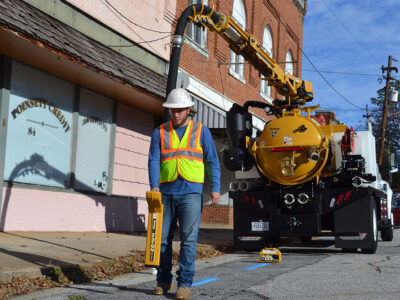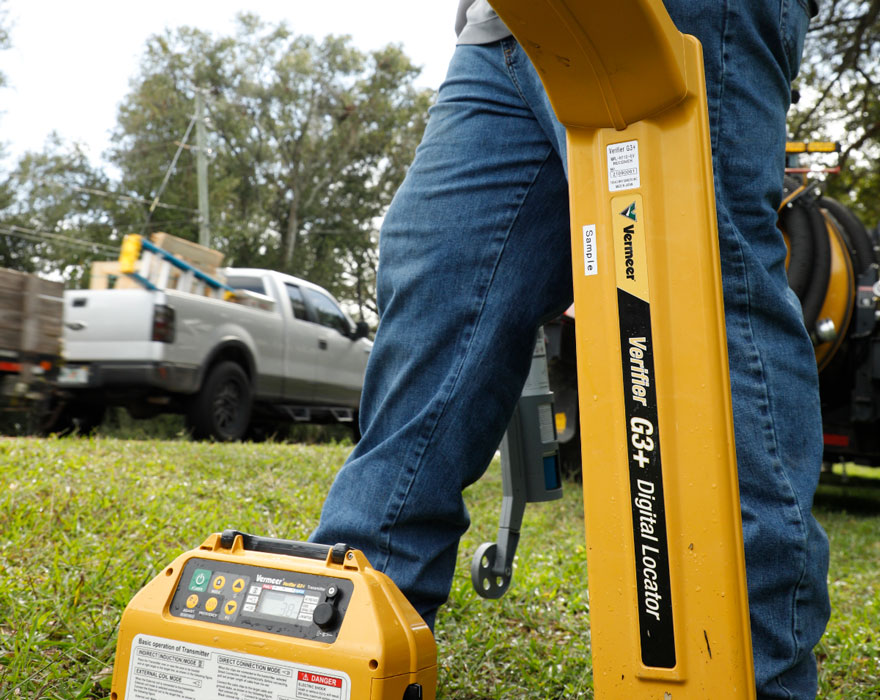With the demand for faster data speeds increasing, more utility lines are going from overhead to underground. This has led to a lot of underground congestion, weaving new lines through crowded utility rights-of-way. Because of this, horizontal directional drilling (HDD) crews need to spend just as much time planning as they do drilling.
The old saying in the carpentry business is “measure twice, cut once.” Underground contractors who want to avoid utility strikes should follow a similar mantra: “locate twice to avoid an accidental cut.” Simply calling 811 and waiting for someone to come out to mark utilities isn’t enough anymore. Before a crew starts drilling, they should first use their own locator to verify all the marked utilities, as well as anything that may not have been marked. After that, teams need to pothole to confirm depths of all utilities near the bore path, as well as any lines they will intersect along the way.
Why calling in a locate isn’t enough
Tim Selvey is a utility contractor with Bartell & Associates in Tallahassee, Florida.
Bartell & Associates has two HDD crews that perform a mixture of small-diameter telecommunication, water, sewer and powerline bores in and around Tallahassee. Both crews use a Vermeer utility locator to verify U.S. Infrastructure Company (USIC) markings and then pothole any lines that will intersect a bore.
“Locating services usually do a pretty good job of getting everything marked,” said Selvey. “However, there is always a chance they missed something. Someone has an off day, or a nonconductive line isn’t documented, so they aren’t necessarily looking for it. We hear those types of stories all the time, which is why we invest in locating equipment and take the time to teach our team how to use it.”
Importance of support and training
Just having and using a utility locator isn’t enough — HDD crew members must understand how to use them too. According to Selvey, he was concerned about locator training before investing in his first locator. “If people don’t know how to use a locator, they aren’t going to use it properly. Then, before you know it, the locator is just sitting on a shelf collecting dust. We didn’t want that to happen. We consulted with our Vermeer Southeast sales representative for proper training before purchasing two McLaughlin Verifier G2 utility locators a few years back and when upgrading to the Vermeer® Verifier G3® locator.”
The team at Vermeer Southeast helped Bartell & Associates crew members learn how to use the locators, and Selvey said his team is now self-sufficient at training new employees. “The Vermeer locator is pretty easy to learn how to use, and it is accurate,” he said. “When one team member is training another, he or she will show them how to hook on to a particular utility line, listen for the tone and then pothole to verify they did everything accurately. It’s usually a pretty quick process.”
Crowded underground
Selvey also explained another benefit of using a locator in conjunction with potholing utilities: the ability to reduce the risk of misidentifying a utility. “In a lot of the areas where we work, we’ll run into utility lines being stacked on top of each other,” he said. “If a crew member isn’t paying attention to everything buried in a spot, they may only expose the top utility, which could lead to a utility strike or cross bore. On jobs like that, it’s important for us to directly connect to each utility so we can have pinpoint accuracy of where every line is going and the approximate depths. After that, we will dig until every line is daylighted.”
What’s at stake
Selvey spends time with his team reinforcing the company’s process for verifying utility locations to mitigate the risk of a utility strike. “We’re a small company with a good reputation. All of our business is through word of mouth — we don’t even have a website,” he said. “Utility companies know we do good work, which is why we always have plenty of it. It’s important to us that we keep it that way.”
Spending time on the front end of an HDD project verifying locates and exposing existing utilities should be part of every contractor’s process. Talk to your Vermeer dealer about how a Vermeer utility locator could help your operation.
This article contains third-party observations, advice or experiences that do not necessarily reflect the opinions of Vermeer Corporation, its affiliates or its dealers. Testimonials and/or endorsements by customers in specific circumstances may not be representative of normal circumstances experienced by all customers
Vermeer MV Solutions, Inc. reserves the right to make changes in engineering, design and specifications; add improvements, or discontinue manufacturing at any time without notice or obligation. Equipment shown is for illustrative purposes only and may display optional accessories or components specific to their global region. Please contact your local Vermeer dealer for more information on machine specifications.
Vermeer, the Vermeer logo and Verifier are trademarks of Vermeer Manufacturing Company in the U.S. and/or other countries. © 2023 Vermeer MV Solutions, Inc. All Rights Reserved.

